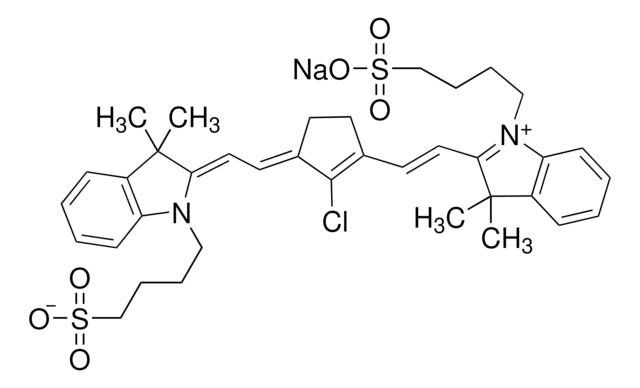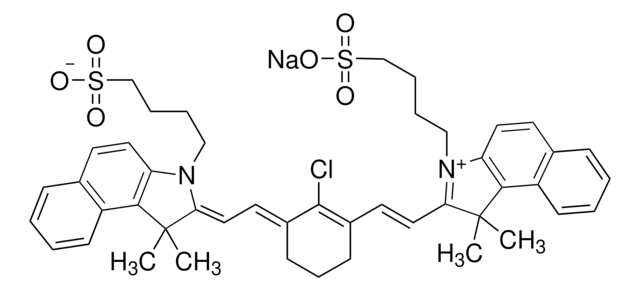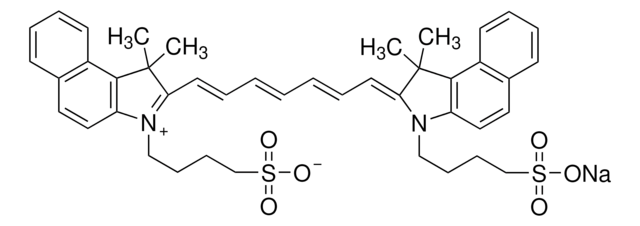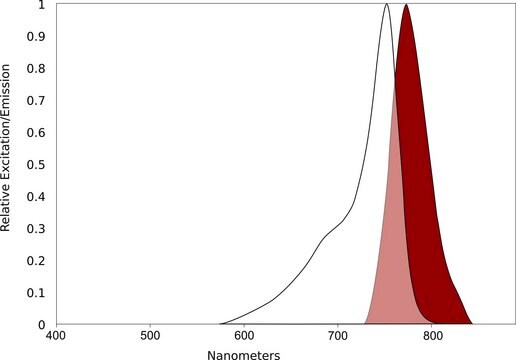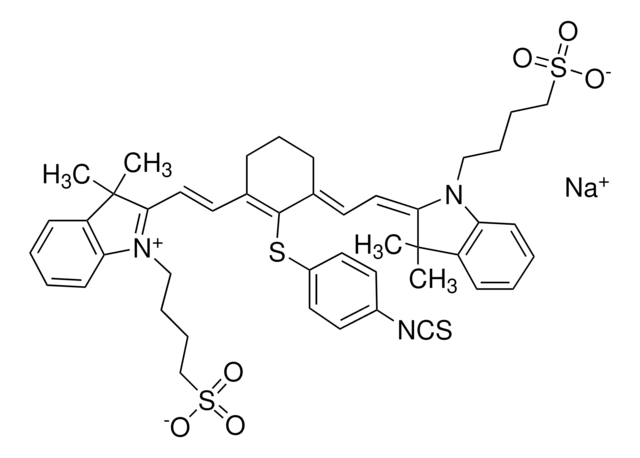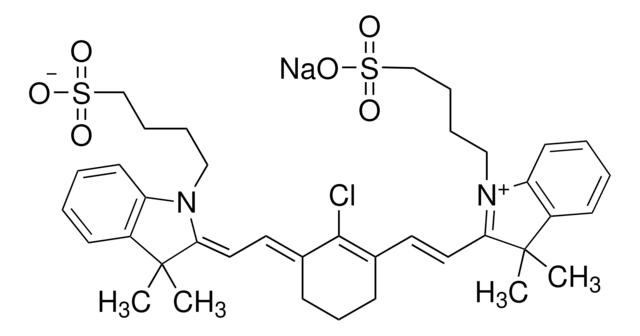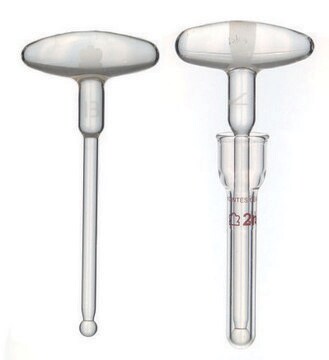おすすめの製品
品質水準
アッセイ
≥90% (TLC)
フォーム
solid
分子量
~3,009 g/mol (free acid)
溶解性
DMF: soluble
DMSO: soluble
H2O: soluble
&ε; (減衰係数)
250000 at 755 nm
吸光度比
A280/755 nm 0.03
蛍光検出
λex 680 or 685 nm (Flow cytometry laser line)
λex 680 or 685 nm (Microscopy laser line)
λex 755 nm; λem 777 nm
適合性
suitable for fluorescence
輸送温度
wet ice
保管温度
−20°C
詳細
CF™ 750 succinimidyl ester (CF750 SE) is used for labeling proteins or other biomolecules having an amine group. The succinimidyl ester group of the dye reacts with an amine group to form a stable amide linkage.
Near-IR CF dyes are a group of fluorescent dyes with absorption and emission wavelengths between 650 and 800 nm. Near-IR CF dyes are significantly brighter and more stable than any other commercial dye of similar wavelengths. Near-IR CF dyes offer important advantages over traditional visible light dyes. Because cellular or tissue components produce minimal autofluorescence in the near-IR region, near-IR dyes have the potential to offer highly specific and sensitive detection in complex biological systems. Also, because light with wavelength in the near-IR region has strong tissue penetration, near-IR dyes are ideal for in vivo fluorescence imaging, an emerging field that has advanced rapidly in recent years. Futhermore, near-IR dyes are also excellent dyes for in- or on-cell and membrane-based Western assays. CF750 is so bright, it can be excited at 633 nm, but still emits stronger fluorescence at ~770 nm than APC-based tandem dyes, making the dye particularly useful for flow cytometry applications without the spillover and stability challenges encountered with tandem dyes.
アプリケーション
CF™ 750 succinimidyl ester is suitable for labelling antibodies during for xenograft Imaging of CD25-positive tumors. It may also be used for labelling proteins to track the protein delivery in nasal mucosa using nanoparticles containing an anionic lipid in their core (NPL).
特徴および利点
1. 近赤外CF色素は輝度と安定性に極めて優れています。2. 水溶性です。3. in vivoイメージングに理想的です。4. その他競合する色素製品と比べて、免疫原性が低くなっています。
調製ノート
遮光し、湿気を避けてください。
再構成
DMSOに溶解してください。
法的情報
本製品はBiotium, Inc.の承諾を受け、シグマ アルドリッチが販売しています。本製品は、一つ以上の米国特許、あるいはこれに相当しBiotium, Inc.により所有または許諾された米国特許以外の特許請求項や係属中の特許出願によって保護されており、12/334,387; 12/607,915; 12/699,778; 12/850,578; 61/454,484の限りではありません。購入者より支払われた購入価格の対価として、購入者には製品添付書に合致する方法で自身の内部的研究においてのみ購入した製品量を使用することに対し、限定的、非独占的かつ譲渡不可のライセンスが供与されます。ここに明記された場合を除き、この製品の販売においてはBiotium, Inc.のあらゆる特許権その他知的所有権にもとづく明示的、暗示的または禁反言による購入者のいかなる実施権を付与あるいは譲渡するものではありません。また、購入者はこの製品を第三者に転売、譲渡あるいは任意の商業目的のほか、診断、治療、予防などを目的に使用することはできません。本製品は研究専用です。診断使用をはじめ、その他を目的とする使用についてはBiotium, Inc.からの別途ライセンスが必要となります。研究用以外でこの製品を使用する場合のライセンス購入に関する情報は、以下にお問い合わせください。Biotium, Inc., 3159 Corporate Place, Hayward, CA 94545, Tel: (510) 265-1027. Fax: (510) 265-1352. Email: btinfo@biotium.com.
CF is a trademark of Biotium, Inc.
免責事項
Unless otherwise stated in our catalog or other company documentation accompanying the product(s), our products are intended for research use only and are not to be used for any other purpose, which includes but is not limited to, unauthorized commercial uses, in vitro diagnostic uses, ex vivo or in vivo therapeutic uses or any type of consumption or application to humans or animals.
保管分類コード
11 - Combustible Solids
WGK
WGK 3
引火点(°F)
Not applicable
引火点(℃)
Not applicable
適用法令
試験研究用途を考慮した関連法令を主に挙げております。化学物質以外については、一部の情報のみ提供しています。 製品を安全かつ合法的に使用することは、使用者の義務です。最新情報により修正される場合があります。WEBの反映には時間を要することがあるため、適宜SDSをご参照ください。
Jan Code
SCJ4600059-1UMOL:
最新バージョンのいずれかを選択してください:
RNA interference in vitro and in vivo using DsiRNA targeting the nucleocapsid N mRNA of human metapneumovirus.
Darniot, M., et al.
Antiviral Research, 3, 364-373 (2012)
B Bernocchi et al.
Journal of controlled release : official journal of the Controlled Release Society, 232, 42-50 (2016-04-16)
The intranasal administration of proteins using nanoparticles is a promising approach for several applications, especially for mucosal vaccines. Delivery of protein within the epithelial barrier is a key point to elicit an immune response and nano-carrier has to show no
ライフサイエンス、有機合成、材料科学、クロマトグラフィー、分析など、あらゆる分野の研究に経験のあるメンバーがおります。.
製品に関するお問い合わせはこちら(テクニカルサービス)
